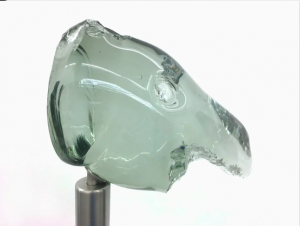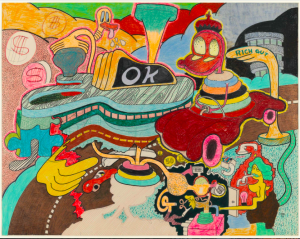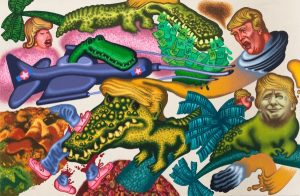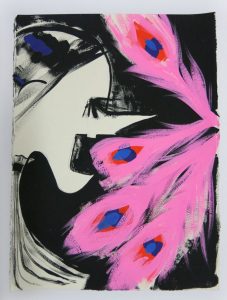Pop, Funk, and Anti-Heroes: The Schirn Kunsthalle Frankfurt Presents The Idiosyncratic Painting of Peter Saul in a major survey exhibition. Fad’s correspondent, curator and collector Kwaku managed to get an exclusive interview with Peter before the opening.

Peter Saul in his studio in Mill Valley, California, 1974, B/w Photograph, 25,2 x 20,4 cm, © Peter Saul, Collection of the artist
Your style has been consistently weird for a long time however you like to take risk’s when painting and for me that’s exciting. What drives you today and do you feel you have the same energy to push the boundaries of what is possible in painting?
I pay a lot of attention to the subject matter of the individual picture and try to have a fresh and obvious approach. The “ideas and theories” of painting are not very interesting to me because they don’t last very long, 20 or 30 years at the most,but if they help the picture to look interesting I’ll make good use of them.
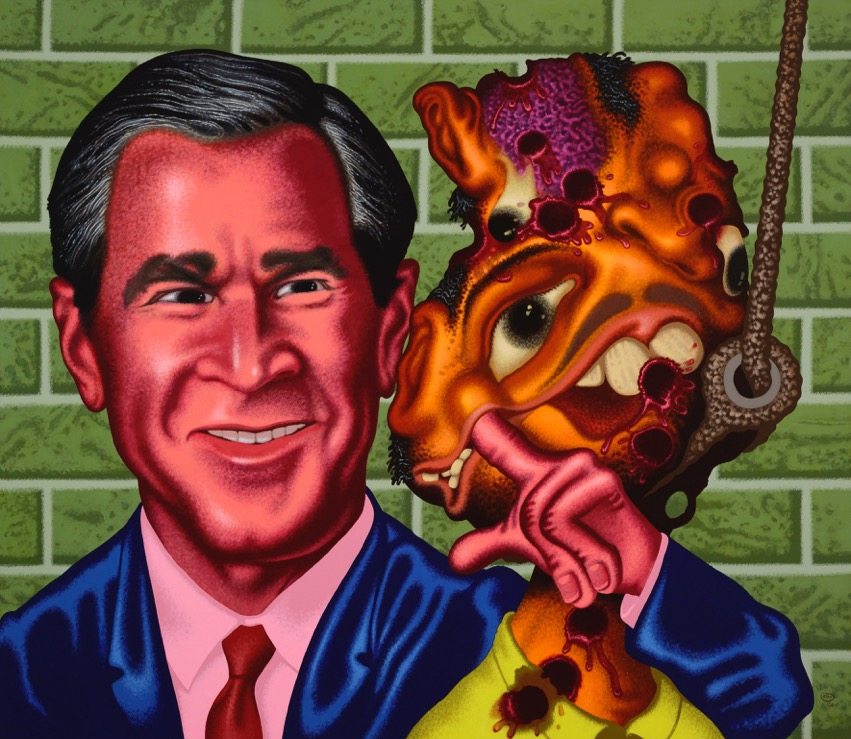
Peter Saul, Bush at Abu Ghraib, 2006, Acrylic on canvas, 198 x 228,5 cm, Hall Collection, © Peter Saul, Courtesy Hall Art Foundation, Photo: Jeffrey Nintzel
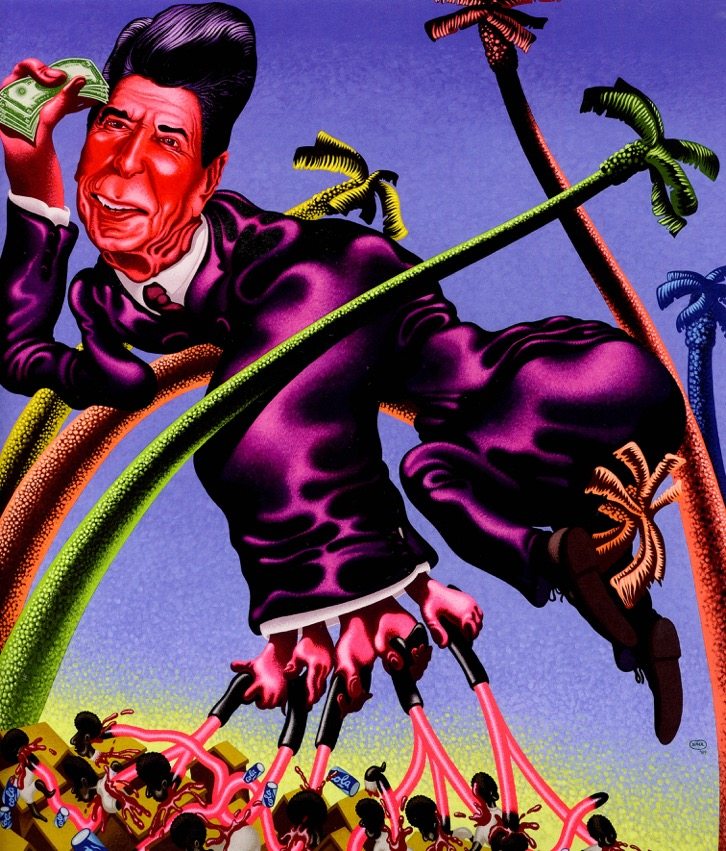
Peter Saul, Ronald Reagan in Grenada, 1984, 210 x 180 cm, Acrylic on canvas, Hall Collection, © Peter Saul, Courtesy Hall Art Foundation, Photo: Jeffrey Nintzel
For a long time you have addressed political and social issues as central themes in your paintings. Today with such political degradation globally do you feel it necessary to attack certain forces or issues that currently effect America and the rest of the world?
I don’t think painting a picture is very useful in attacking any forces that affect America and the rest of the world. I think my pictures function best as modern art. My actual political ideas are too commonplace and leftist to be of much interest. If possible I’ll have my picture agree with those ideas but it rarely happens. I let the picture do what is best for it.
Sometimes it is interesting to see how artists re-tool the past. Which period do you keep coming back to in art history and who do you look to for inspiration
I like the whole 19 century – Manet, Monet, Gerome, Whistler, Gaugin, Rosa Bonheur, the whole thing irregardless of fame or style, the collision between the subject matter and the style I find very exciting.
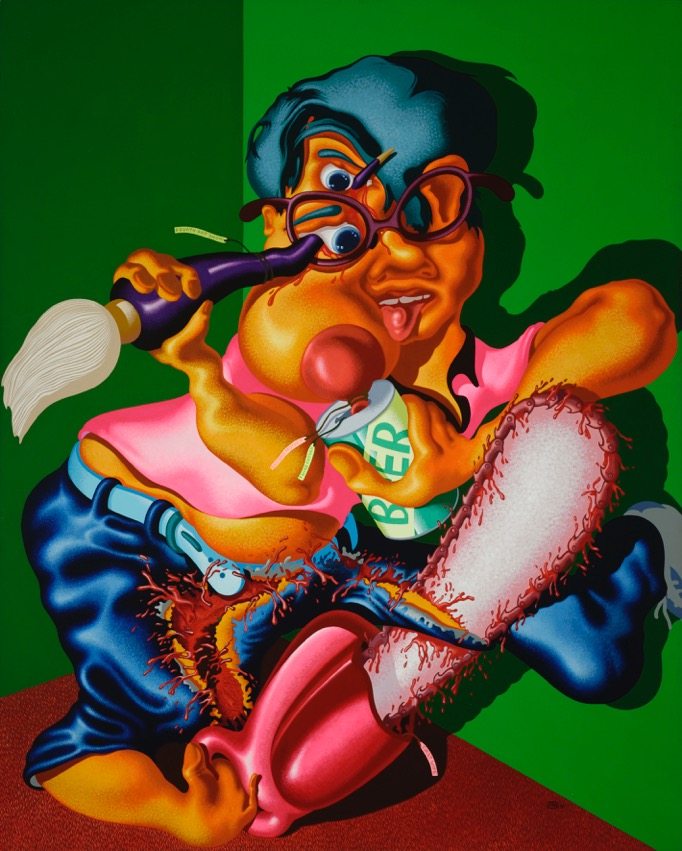
Peter Saul, Oedipus Jr., 1983, Acrylic and oil on canvas, 228,5 x 183 cm, Hall Collection, © Peter Saul, Courtesy Hall Art Foundation, Photo: Jeffrey Nintzel
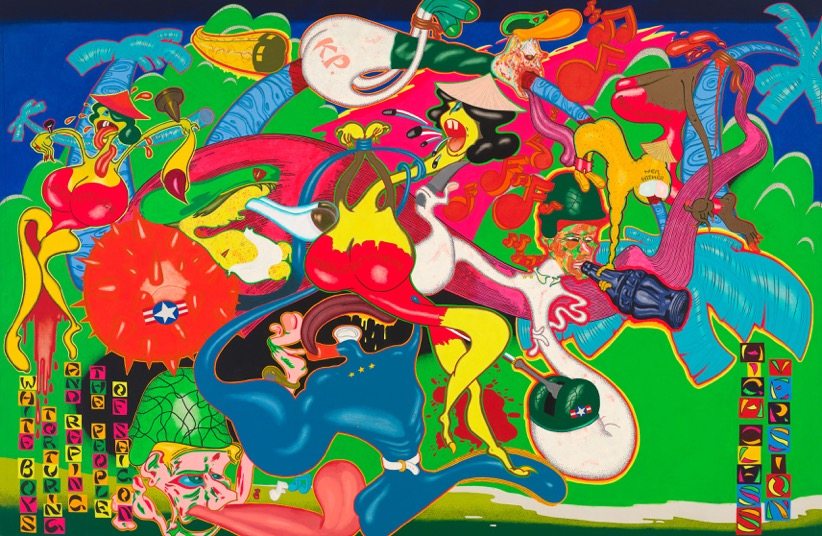
Peter Saul, Saigon, 1967, Acrylic, oil, enamel, and ink on canvas, 236,9 x 361,3 cm, Whitney Museum of American Art, © Peter Saul, Photo: Sheldon C. Collins
If you could be in the studio of a surrealist from the 20’s or 30’s who would it be?
Salvador Dali is one of my favorite artists, so I would visit his studio.
What is harder to paint: Donald Trump or Hitler ?
Donald Trump is much harder to paint than Hitler because 10,000 other artists are painting him, and every conceivable sexual, financial and political viewpoint is being covered many times from all angles. Hitler has no artist attending to him at this time and is entirely fresh material.
What’s are your favorite museums globally other than the Schirn Kunsthalle?
Musée d’Orsay in Paris and the Whitney and the Metropolitan Museum in New York City are my favorites.
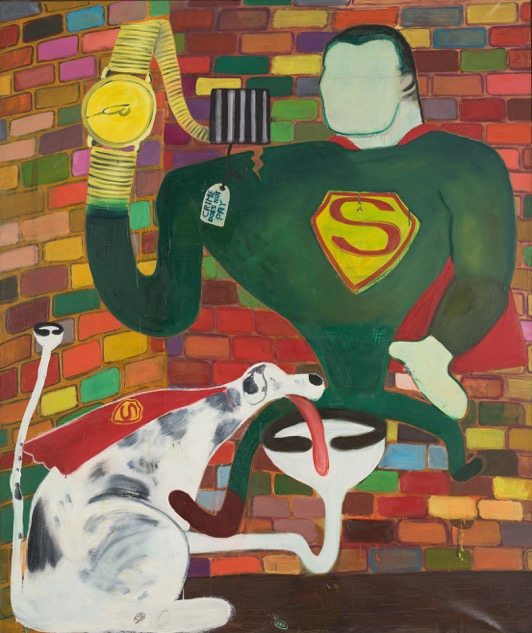
Your wife Sally is a very cool ceramic artist. Have your ever thought about making sculpture (because to be honest that would be incredible)?
Yes, I have made sculptures between about 1966 and 1970. There are only a couple extant, the rest broke apart. The problem with sculpture you need helpers and money, which I was reluctant to involve myself with. My idea of art is just me in the room with a bare canvas which I then paint on. A large sculpture I made called “Dirty Guy” or “Man in the Electric Chair” does exist in the diRosa Foundation Museum collection in Napa, California. A smaller sculpture is owned by the Smart Museum in Chicago, and in the 70’s I collaborated with a ceramicist, Clayton Bailey, and we made several ambitious sculptures.
Have you every painted a self-portrait?
I did paint one self-portrait but it wasn’t nearly as good as a number of the distorted heads I painted in the 80’s and 90’s which are maybe me rather than the subject they’re supposed to be. I also figured in a few earlier works made between 1968 and 1971.
Is there a particular film that had a big impact on you?
No, I don’t think there’s a particular film that had a big impact.
Do you listen to music in your studio and if so what exactly?
Yes, I listen to music, usually classical music, but occasionally country and western, and sometimes Christmas carols. It doesn’t seem to matter to me very much what kind of music I’m listening to, but the voices of the announcers sometimes annoy me.
Where do you escape to think about the paintings you create?
I don’t need to escape, I can think about my pictures just about anywhere.
What do you see as the task of contemporary art today?
The task of contemporary painting as I see it is to be about something besides the way it’s made. There’s nothing wrong with painting being about itself, but that’s already happened, and it looks like it’s going to need to have something to do with the outside world to continue to be interesting.
Are there any surprises we should look out for in this Restropective at Schrin Kunsthalle
I’m not entirely sure what pictures are in the show. But there will be a few early drawings made between 1958 and 1960 that have never been shown.
POP, FUNK, AND ANTI-HEROES: THE SCHIRN KUNSTHALLE FRANKFURT PRESENTS THE IDIOSYNCRATIC PAINTING OF PETER SAUL IN A MAJOR SURVEY EXHIBITION PETER SAUL JUNE 2 – SEPTEMBER 3, 2017 SCHIRN KUNSTHALLE FRANKFURT Römerberg 60311 Frankfurt www.schirn.de/en
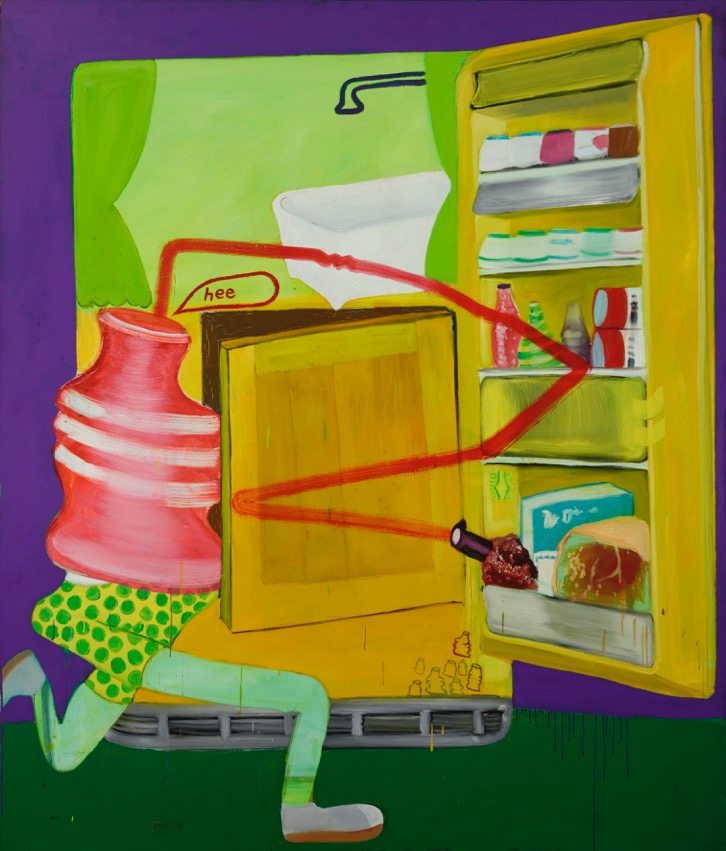
Peter Saul, Ice Box 8, 1963, Oil on canvas, 190 x 160 cm, Hall Collection, © Peter Saul, Courtesy Hall Art Foundation, Photo: Jeffrey Nintzel
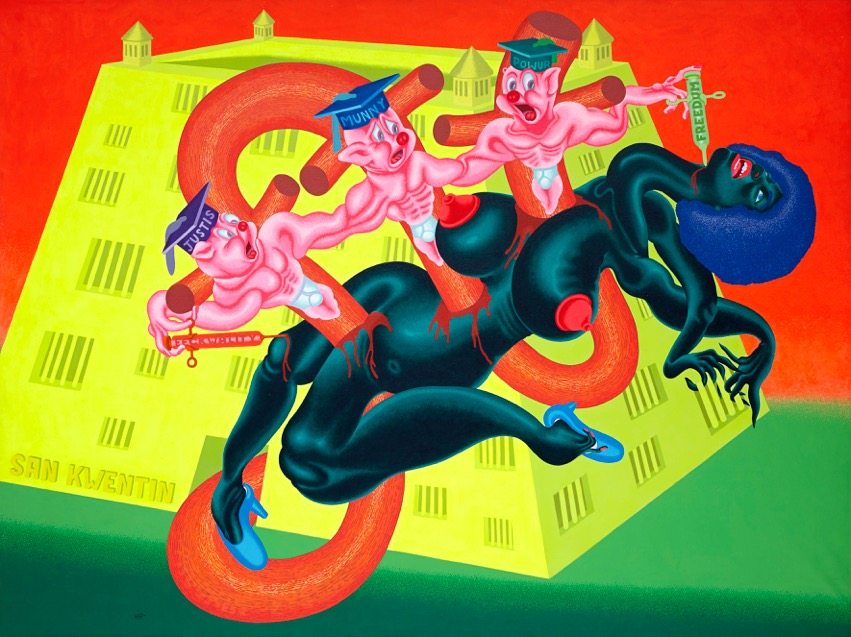
Peter Saul, San Quentin # 1 (Angela Davis at San Quentin), 1971, Oil on canvas, 180,3 x 238,8 cm, © Peter Saul, Collection of KAWS
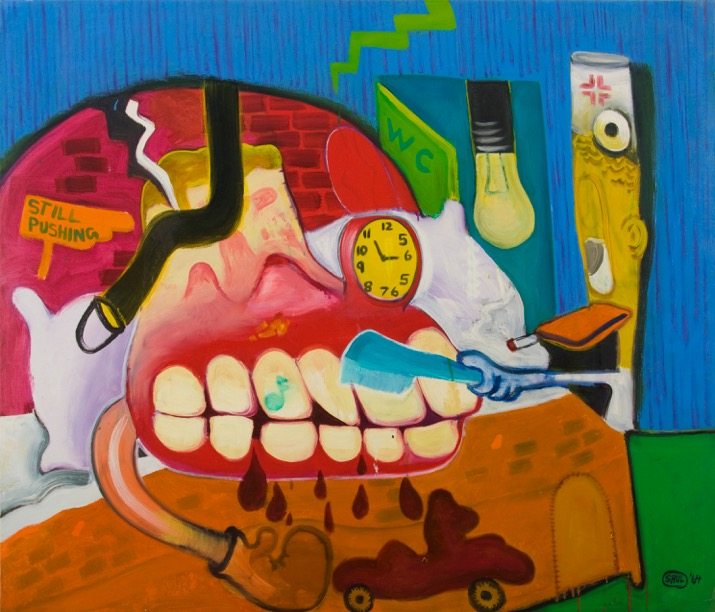
Peter Saul, Sickroom, 1964, Oil on canvas, 128,3 x 149,8 cm, Collection of the artist Peter Saul, © Peter Saul, Courtesy Mary Boone Gallery, New York
#PeterSaul #Schirn

